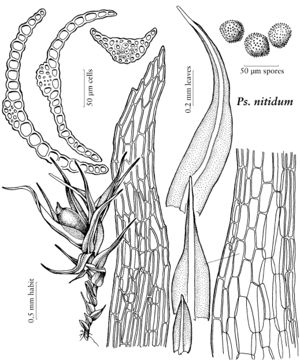Pseudephemerum nitidum
Stud. Morph. Laubm., 75. 1910,.
Stem-leaves erect-spreading, lanceolate, to 1.8 mm at stem tip, base ovate, margins plane, entire, serrulate at the flat apex. Seta 1 (–2), short, erect. Capsule pale-brown, 0.5–0.65 mm, ovoid with a short point, smooth, exothecial cells hyaline, quadrate, stomata only on proximal part of capsule. Calyptra 0.3–0.4 mm.
Phenology: Capsules mature Nov.
Habitat: Damp soil, silt hammocks in grassy areas near river banks
Elevation: low to moderate elevations
Distribution

B.C., Oreg., Mexico, South America, Europe, Asia (Assam), Asia (Japan), Asia (Nepal), Africa (Congo), Africa (Kenya), Africa (Rwanda), Africa (Uganda), Africa (Zaire), Indian Ocean Islands (Madagascar), Pacific Islands (New Zealand), Australia (Tasmania)
Discussion
This species is readily recognized by the lax and undifferentiated leaf cells, and the serrulate leaf tips. Vegetatively, it is superficially similar to Pohlia, Bryum, or Leptobryum species by the thin-walled laminal cells and the serrated leaf apices, but the rough papillose rhizoids of these genera distinguish them from Pseudephemerum nitidum. E. Nyholm (1986+) reported asexual reproduction of P. nitidum by spherical gemmae. Pseudephemerum nitidum is newly reported from Oregon and Mexico from similar habitats (Yip K. L. 2002). The previous reports of this species in Canada could be verified only from a specimen from Richmond, British Columbia (Schofield 22437, UBC, WTU). A Nova Scotia report could not be confirmed after re-examination of the reported specimens (Yip 1998).
Selected References
None.
